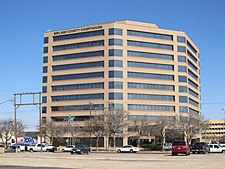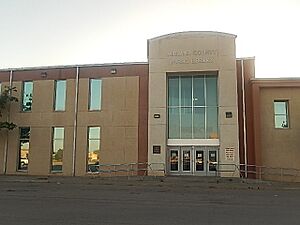Midland County, Texas facts for kids
Quick facts for kids
Midland County
|
||
|---|---|---|

The Midland County Courthouse in Midland
|
||
|
||

Location within the U.S. state of Texas
|
||
 Texas's location within the U.S. |
||
| Country | ||
| State | ||
| Founded | 1885 | |
| Named for | Midland, Texas | |
| Seat | Midland | |
| Largest city | Midland | |
| Area | ||
| • Total | 902 sq mi (2,340 km2) | |
| • Land | 900 sq mi (2,000 km2) | |
| • Water | 1.8 sq mi (5 km2) 0.2% | |
| Population
(2020)
|
||
| • Total | 169,983 | |
| • Density | 188.45/sq mi (72.76/km2) | |
| Time zone | UTC−6 (Central) | |
| • Summer (DST) | UTC−5 (CDT) | |
| Congressional district | 11th | |
Midland County is a county in the state of Texas, USA. In 2020, about 170,000 people lived here. The main city and county seat is Midland.
The county got its name because it's about halfway between Fort Worth and El Paso. These cities are connected by the Texas and Pacific Railway. Midland County is also part of the larger Midland–Odessa area.
Contents
History of Midland County
In 1968, a big court case called Avery v. Midland County happened. The Supreme Court decided that local voting districts must be almost equal in population.
Before this, the city of Midland had most of the county's people. But it only elected one of the five county leaders, called commissioners. The Supreme Court said this was unfair. It went against the Fourteenth Amendment, which promises equal protection under the law.
Geography and Location
Midland County covers about 902 square miles (2,336 square kilometers). Most of this area, about 900 square miles, is land. Only a small part, about 1.8 square miles, is water.
A very important oil field, the Spraberry Trend, is located under much of the county. It's the third-largest oil field in the United States.
Main Roads in Midland County
These are some of the major highways that run through Midland County:
 I-20
I-20 Bus. I-20
Bus. I-20 SH 137
SH 137 SH 140
SH 140 SH 158
SH 158 SH 191
SH 191 SH 349 (Nadine and Tom Craddick Highway)
SH 349 (Nadine and Tom Craddick Highway) Loop 40
Loop 40 Loop 250
Loop 250 Loop 268
Loop 268
Neighboring Counties
Midland County shares borders with several other counties:
- Martin County (north)
- Glasscock County (east)
- Upton County (south)
- Ector County (west)
- Andrews County (northwest)
- Reagan County (southeast)
Population and People
| Historical population | |||
|---|---|---|---|
| Census | Pop. | %± | |
| 1890 | 1,033 | — | |
| 1900 | 1,741 | 68.5% | |
| 1910 | 3,464 | 99.0% | |
| 1920 | 2,449 | −29.3% | |
| 1930 | 8,005 | 226.9% | |
| 1940 | 11,721 | 46.4% | |
| 1950 | 25,785 | 120.0% | |
| 1960 | 67,717 | 162.6% | |
| 1970 | 65,433 | −3.4% | |
| 1980 | 82,636 | 26.3% | |
| 1990 | 106,611 | 29.0% | |
| 2000 | 116,009 | 8.8% | |
| 2010 | 136,872 | 18.0% | |
| 2020 | 169,983 | 24.2% | |
| U.S. Decennial Census 1850–2010 2010 2020 |
|||
| Race / Ethnicity (NH = Non-Hispanic) | Pop 2000 | Pop 2010 | Pop 2020 | % 2000 | % 2010 | % 2020 |
|---|---|---|---|---|---|---|
| White alone (NH) | 72,015 | 72,822 | 76,487 | 62.08% | 53.20% | 45.00% |
| Black or African American alone (NH) | 7,940 | 8,675 | 10,465 | 6.84% | 6.34% | 6.16% |
| Native American or Alaska Native alone (NH) | 415 | 552 | 686 | 0.36% | 0.40% | 0.40% |
| Asian alone (NH) | 1,040 | 1,639 | 3,891 | 0.90% | 1.20% | 2.29% |
| Pacific Islander alone (NH) | 16 | 42 | 152 | 0.01% | 0.03% | 0.09% |
| Other race alone (NH) | 52 | 211 | 621 | 0.04% | 0.15% | 0.37% |
| Mixed race or Multiracial (NH) | 855 | 1,331 | 4,350 | 0.74% | 0.97% | 2.56% |
| Hispanic or Latino (any race) | 33,676 | 51,600 | 73,331 | 29.03% | 37.70% | 43.14% |
| Total | 116,009 | 136,872 | 169,983 | 100.00% | 100.00% | 100.00% |
In 2000, there were 116,009 people living in Midland County. There were 42,745 households and 30,947 families. The population density was about 129 people per square mile.
About 38.9% of households had children under 18 living with them. Most households (57.4%) were married couples. About 24.2% of households were individuals living alone. The average household had 2.68 people.
The population was spread out by age. About 30.2% were under 18 years old. About 11.6% were 65 years or older. The average age was 34 years.
Oil and Gas Production
Midland County is a very important area for the oil and gas industry in Texas. It ranks number one in the state for how much oil it produces. It's also number two for how much natural gas it produces.
As of September 2020, there were 6,602 active oil and gas wells in the county. This shows how much the area relies on this industry.
Cities and Towns
Midland County has several communities, including cities and smaller towns.
Cities in Midland County
- Midland (This is the county seat, where the main county government offices are. A small part of Midland is in Martin County.)
- Odessa (Part of Odessa is also in Ector County.)
Unincorporated Communities
These are smaller communities that are not officially cities or towns:
Former Towns (Ghost Towns)
These are places that used to be towns but are now abandoned:
- Dameron City
- Germania
- Pleasant
- Prairie Lee
- Slaughter
Education in the County
Students in Midland County attend schools in different school districts:
- Midland Independent School District
- Greenwood Independent School District
Most areas in the county are served by Midland College, which is a community college. However, the Greenwood area is not part of the Midland College service area.
See also
 In Spanish: Condado de Midland (Texas) para niños
In Spanish: Condado de Midland (Texas) para niños




